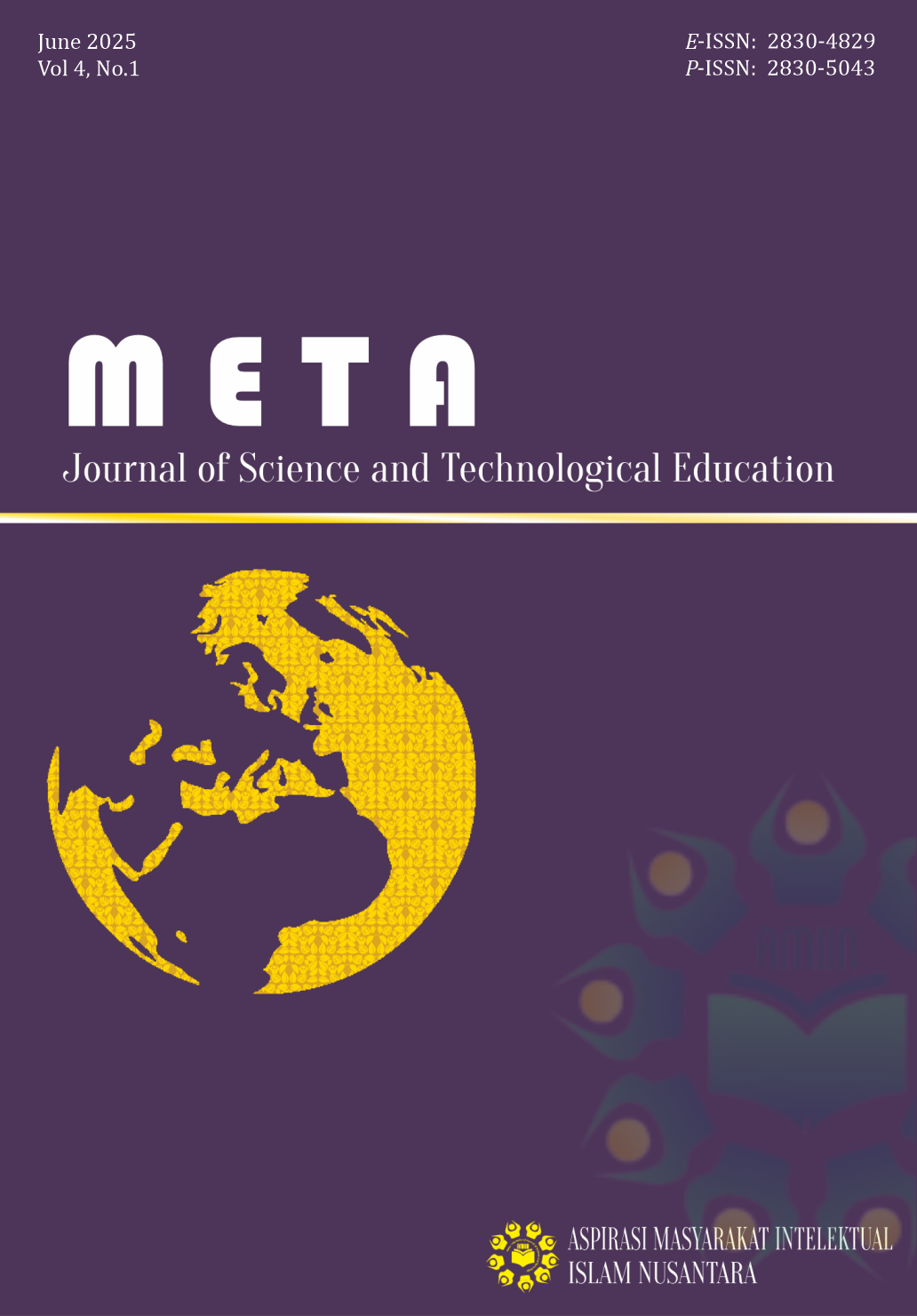Analysis of the Digital Literacy Skills of Grade XI Senior High School Students in Online Biology Learning
Keywords:
Covid-19, Online Learning, Digital Literacy, Senior high schoolAbstract
The Covid-19 pandemic has made changes to several aspects of life such as education. Online learning is a new challenge for educators and students and mastery of using digital media is the key to successful education during a pandemic. This study aims to determine the digital literacy ability profile of class XI high school students in learning dare biology during the Covid-19 pandemic. The benefits of this research are providing knowledge and motivation for students, providing views and input for educators in developing learning strategies. This study used a descriptive quantitative method with instruments used in data collection in the form of validation sheets, questionnaire sheets and interview lists. The digital literacy component includes 8 digital literacy components. The results obtained on the functional skill component with an average of 86.91%, the creative component with an average of 77.79%, the average collaboration component is 71.07%, the ability to search for and select information with an average 77.10%, the critical thinking and evaluation component with an average of 76.20%, the socio-cultural understanding component with an average of 75.29%, the security component with an average of 84.82%. All of these components are known to mean that the average digital literacy ability of class XI students at SMA 3 Pekanbaru City gets a score of 78.81%. Based on these results, it can be interpreted that the Digital Literacy Ability of Class XI High School Students in Biology Online Learning during the Covid-19 Pandemic Period is in the Good category.
References
Abbas, E. W. (2020). Menulis di Era Covid-19: Memanage Trauma Psikologis Menghindari Psikosomatis. … -19: Memanage Trauma Psikologis …, 1–28. http://eprints.ulm.ac.id/9187/1/2.MenulisdiEraCovid-19MemanageTraumaPsikologisMenghindariPsikosomatis.pdf
Adijaya, N., & Santosa, L. P. (2018). Persepsi Mahasiswa Dalam Pembelajaran Online. Wanastra, 10(2), 550. http://ejournal.bsi.ac.id/ejurnal/index.php/wanastra
Amini, N. A. (2020). Impact of the Covid-19 pandemic on the education sector especially. Jurnal Pendidikan Psikologi, 4(1), 86–87.
Bentley, Y., Selassie, H., & Shegunshi, A. (2012). Design and Evaluation of Student-Focused eLearning. 10(1), 1–12.
Dewi, P. S., & Septa, H. W. (2019). Peningkatan Kemampuan Pemecahan Masalah Dan Disposisi Matematis Siswa Dengan Pembelajaran Berbasis Masalah. Mathema Journal, 1(1), 31–39. https://ejurnal.teknokrat.ac.id/index.php/jurnalmathema/article/view/352
Hasan, M. I. (2002). Pokok Pokok Metodologi Penelitian dan Aplikasinya. In Jakarta Ghalia Indonesia (Vol. 1). bisnis ritel - ekonomi
Heriyanto. (2018). Kompetensi Literasi Media Digital Siswa Kelas X Pada SMA Beryayasan Budhis di Tangerang. Jurnal Vijjacariya, 5(2), 17–32.
Mulyasa, E. (2009). Menjadi Guru Profesional Menciptakan Pembelajaran Kreatif Cet. VIII. PT. Remaja Rosdakarya, Bandung.
Nasionalita, K., & Nugroho, C. (2020). Indeks Literasi Digital Generasi Milenial di Kabupaten Bandung. Jurnal Ilmu Komunikasi, 18(1), 32. https://doi.org/10.31315/jik.v18i1.3075
Naufal, H. A. (2021). Literasi Digital. Perspektif, 1(2), 195–202. https://doi.org/10.53947/perspekt.v1i2.32
Nur, M. (2019). Literasi Digital Keagamaan Aktivis Organisasi Keagamaan Di Madrasah Aliyah Negeri (Man) Di Kota Bandung. Jurnal SMART (Studi Masyarakat, Religi, Dan Tradisi), 5(1), 1–14. https://doi.org/10.18784/smart.v5i1.745
Perwita, D. (2021). Literasi Media Digital Mahasiswa Universitas Jenderal Soedirman. EQUILIBRIUM : Jurnal Ilmiah Ekonomi Dan Pembelajarannya, 9(1), 8. https://doi.org/10.25273/equilibrium.v9i1.8515
Puspaningtyas, N. D. (2019). Proses Berpikir Lateral Siswa SD dalam Menyelesaikan Masalah Matematika Open-Ended Ditinjau dari Perbedaan Gaya Belajar. MAJAMATH: Jurnal Matematika Dan Pendidikan Matematika, 2(2), 80. https://doi.org/10.36815/majamath.v2i2.373
Restianty, A. (2018). Literasi Digital, Sebuah Tantangan Baru Dalam Literasi Media. Gunahumas, 1(1), 72–87. https://doi.org/10.17509/ghm.v1i1.28380
Sholikhah, A. (2016). ST A TISTIK DESKRIPTIF A TIF Amirotun Sholikhah. Komunika, 10(2), 342–362.
Sugiyono. (2016). Metode Penelitian Kuantitatif, Kualitatif, R&D. Bandung : Alfabeta.
Suhendi, H. Y. (2017). Profil Kemampuan Literasi Teknologi Peserta Didik Sekolah Menengah Atas Di Kota Bandung. Journal of Teaching and Learning Physics, 2(2), 1–6. https://doi.org/10.15575/jotalp.v2i2.6567
Sujana, A., & Rachmatin, D. (2019). Literasi Digital Abad 21 Bagi Mahasiswa PGSD: Apa, Mengapa, dan Bagaimana. Conference Series Journal, 1(1), 1–7. https://ejournal.upi.edu/index.php/crecs/article/view/14284
Sukri, M. (2021). Literasi Digital Sebagai Media Pembelajaran Dalam Perspektif Pendidikan Islam. Universitas Islam Negeri Raden Intan Lampung, April, 1–126.
Syah, R. H. (2020). Dampak Covid-19 pada Pendidikan di Indonesia: Sekolah, Keterampilan, dan Proses Pembelajaran. SALAM: Jurnal Sosial Dan Budaya Syar-I, 7(5). https://doi.org/10.15408/sjsbs.v7i5.15314
Syamsuddin, S. (2021). Dampak Pembelajaran Daring Di Masa Pandemic Covid-19 Terhadap Motivasi Belajar Siswa Sd Inpres 1 Tatura Kota Palu. Guru Tua : Jurnal Pendidikan Dan Pembelajaran, 4(1), 45–50. https://doi.org/10.31970/gurutua.v4i1.65
Teknowijoyo, F. (2022). Relevansi Industri 4.0 dan Society 5.0 Terhadap Pendidikan Di Indonesia. Educatio, 16(2), 173–184. https://doi.org/10.29408/edc.v16i2.4492
Downloads
Published
How to Cite
Issue
Section
License
Copyright (c) 2025 META: Journal of Science and Technological Education

This work is licensed under a Creative Commons Attribution 4.0 International License.











